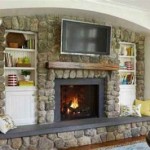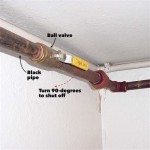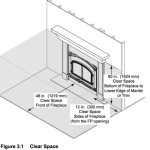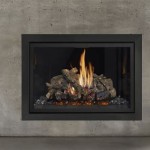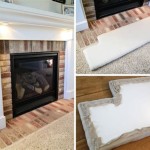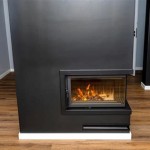Refinishing A Brick Fireplace
A brick fireplace is a quintessential architectural element in many homes, offering warmth, character, and a focal point for living spaces. Over time, however, brick can become stained, discolored, or simply outdated, diminishing its aesthetic appeal. Refinishing a brick fireplace offers a viable solution to revitalize its appearance and integrate it seamlessly into the overall design scheme of a room. This process involves careful preparation, appropriate cleaning techniques, and the application of a chosen finish to achieve the desired aesthetic outcome.
The decision to refinish a brick fireplace necessitates a thorough understanding of the brick's existing condition, the desired aesthetic, and the various refinishing options available. Unlike simply cleaning the brick, which only removes surface dirt and grime, refinishing alters the brick's appearance, often involving painting, staining, or applying a textured coating. This requires careful consideration, as the chosen finish will significantly impact the fireplace's overall look and potentially affect its long-term maintenance requirements.
Preparation: The Foundation for a Successful Refinishing Project
Proper preparation is paramount to achieving a satisfactory and long-lasting result when refinishing a brick fireplace. This phase involves a series of crucial steps designed to protect the surrounding area, thoroughly clean the brick surface, and address any existing damage or imperfections. Neglecting these preparatory steps can lead to adhesion problems, uneven finishes, and ultimately, an unsatisfactory outcome.
The initial step is to protect the surrounding area from dust, debris, and paint splatters. This involves covering the floor with drop cloths, typically canvas or plastic sheeting, extending several feet around the fireplace. Furniture in the vicinity should be moved away or similarly protected. The mantle, if present, should be carefully removed or thoroughly covered with painter's tape and plastic to prevent damage or staining. Any trim or adjoining walls should also be meticulously masked off with painter's tape to ensure clean lines and prevent unwanted paint or stain application.
Cleaning the brick surface is a critical step in the preparation process. Over time, brick can accumulate soot, dust, grease, and other contaminants that can interfere with the adhesion of the chosen finish. The cleaning method will depend on the severity of the staining and the type of finish being applied. For mild staining, a solution of warm water and mild detergent, such as dish soap, can be used. The solution should be applied with a scrub brush, working in circular motions to loosen dirt and grime. For more stubborn stains, a specialized brick cleaner or a solution of trisodium phosphate (TSP) can be used, following the manufacturer's instructions carefully and wearing appropriate protective gear, including gloves and eye protection. After cleaning, the brick surface should be thoroughly rinsed with clean water to remove all traces of the cleaning solution.
Once the brick is clean, it is essential to inspect it for any damage, such as cracks, chips, or crumbling mortar. These imperfections should be repaired before applying any finish. Small cracks can be filled with a masonry crack filler, while larger cracks or chips may require the application of patching compound. Crumbling mortar joints should be raked out and re-pointed with fresh mortar, ensuring a seamless and structurally sound repair. Allow the patching compound or mortar to fully cure according to the manufacturer's instructions before proceeding with the refinishing process. This curing time is crucial for the integrity of the repair and the longevity of the finish.
Choosing the Right Finish: A Matter of Aesthetics and Functionality
Selecting the appropriate finish is a critical decision that will significantly impact the fireplace's appearance and its long-term maintenance requirements. Several options are available, each offering distinct aesthetic qualities and practical considerations. The choice should be based on personal preference, the existing decor of the room, and the desired level of maintenance. Understanding the characteristics of each finish will enable a more informed decision-making process.
Painting is a popular option for refinishing brick fireplaces, offering a wide range of color choices and the ability to completely transform the brick's appearance. It is essential to use a paint specifically formulated for masonry surfaces, such as masonry primer and a high-quality acrylic latex paint. These paints are designed to withstand the alkaline environment of brick and provide good adhesion. Before painting, a masonry primer should be applied to seal the brick surface and promote better paint adhesion. The primer will also help to prevent moisture from seeping through the brick, which can cause the paint to peel or blister. Two coats of paint are typically recommended for optimal coverage and durability. When choosing a paint color, consider the overall color scheme of the room and the desired aesthetic. Lighter colors can brighten a space, while darker colors can create a more dramatic and sophisticated look.
Staining offers a more subtle approach to refinishing brick, enhancing its natural texture and color variations without completely obscuring the brick's original character. Brick stains are designed to penetrate the brick surface, providing a durable and long-lasting finish that won't peel or chip like paint. They are available in a variety of colors, ranging from natural earth tones to more vibrant hues. Before staining, the brick surface must be thoroughly cleaned and free of any existing sealants or coatings. The stain should be applied evenly with a brush, roller, or sprayer, following the manufacturer's instructions carefully. Multiple coats may be necessary to achieve the desired color intensity. Unlike paint, stain allows the brick's natural texture and variations to remain visible, creating a more natural and organic look.
Whitewashing is a technique that involves applying a diluted mixture of white paint to the brick surface, creating a translucent and aged appearance. This method allows some of the brick's original color and texture to show through, providing a subtle and rustic effect. To whitewash a brick fireplace, mix white latex paint with water, typically in a ratio of 1:1or even 1:2 for a more transparent effect. Apply the mixture to the brick surface with a brush or rag, working it into the crevices and mortar joints. Wipe off any excess paint with a clean cloth to reveal the brick's underlying texture. Whitewashing is a relatively easy and inexpensive way to update the look of a brick fireplace, adding a touch of charm and character to the room.
Application Techniques: Achieving a Professional-Looking Finish
The application technique employed when refinishing a brick fireplace is crucial for achieving a professional-looking and long-lasting finish. Whether painting, staining, or whitewashing, proper application techniques ensure even coverage, optimal adhesion, and a aesthetically pleasing result. Utilizing the correct tools and following established methods minimizes the risk of streaks, drips, and other imperfections.
When painting a brick fireplace, begin by applying a coat of masonry primer. Use a brush or roller to apply the primer evenly to the brick surface, ensuring that all crevices and mortar joints are thoroughly covered. Allow the primer to dry completely according to the manufacturer's instructions. Once the primer is dry, apply the first coat of paint. Use a high-quality acrylic latex paint specifically formulated for masonry surfaces. Apply the paint in thin, even coats, working in one direction to avoid streaks. Allow the first coat of paint to dry completely before applying a second coat. The second coat will provide optimal coverage and durability. If necessary, a third coat can be applied to achieve the desired color intensity. When painting, pay close attention to the mortar joints, ensuring that they are fully covered with paint. A small brush can be used to reach into tight corners and crevices.
When staining a brick fireplace, preparation is key. Ensure the brick is thoroughly cleaned and completely dry. Apply the stain evenly with a brush, roller, or sprayer. If using a brush, work the stain into the brick's pores, following the natural texture. Using a sprayer can provide a more uniform application, especially on textured brick. Immediately after application, use a clean cloth to wipe off excess stain. This prevents the stain from pooling and creating an uneven finish. The wiping process also allows you to control the color intensity. For a darker color, leave more stain on the brick; for a lighter color, wipe off more stain. Multiple coats may be required to achieve the desired color depth. Allow each coat to dry completely before applying the next. Always follow the manufacturer's instructions for drying times and application guidelines.
For whitewashing, application is simpler but still requires attention to detail. Dip a brush or rag into the diluted white paint mixture and apply it to the brick surface. Work the mixture into the crevices and mortar joints, ensuring that all areas are covered. Immediately after application, use a clean cloth to wipe off any excess paint. The amount of paint wiped off will determine the translucency of the finish. For a more subtle effect, wipe off more paint; for a more opaque effect, leave more paint on the brick. The wiping technique also allows you to create variations in color and texture. You can wipe some areas more thoroughly than others to create a distressed or aged look. Multiple coats of whitewash can be applied to achieve the desired level of opacity. Allow each coat to dry completely before applying the next, especially if aiming for a layered, textured look.

16 Red Brick Fireplace Makeover Ideas

How To Update A Brick Fireplace With Chalk Paint Diy Beautify Creating Beauty At Home
:max_bytes(150000):strip_icc()/MadetobeaMommaBefore-5bb2476446e0fb002607ad4f.jpg?strip=all)
Before And After Fireplace Makeovers

How To Update A Brick Fireplace With Chalk Paint Diy Beautify Creating Beauty At Home

16 Red Brick Fireplace Makeover Ideas

Brick Fireplace Makeover Before And After Decorating Painting Id Painted Fireplaces Paint
How To Paint A Red Brick Fireplace Look Like Stone

25 Beautiful Diy Brick Fireplace Makeovers

How To Whitewash A Brick Fireplace Easiest Method For 2024

A Step By Guide To Fireplace Refacing Diy Family Handyman
Related Posts

